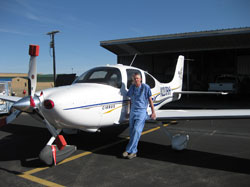 Nurse John Offutt and his Cirrus
Nurse John Offutt and his Cirrus
As a nurse anesthetist and a pilot, John Offutt of Granbury, Texas, has been helping to improve the lives of others for the past 15 years.
In particular, Offutt uses general aviation to fly hundreds of miles to administer anesthesia to patients in rural hospitals in Texas and Oklahoma. Whether the patient is a child who needs to have a tonsillectomy or is a geriatric patient who needs to have a broken hip pinned, traveling 80 to 100 miles for surgery is not an option.
“Patients outside metropolitan areas don’t want to travel long distances or be away from their home and their community,” said Offutt, 59. “They would rather have the operation where they live than in a big city.”
This is why he continues to do his part to help keep the doors of rural hospitals open.
Offutt’s career began in his late 20’s as a registered nurse, watching anesthesiologists during routine surgeries. He thought to himself, “I could do that,” and committed to completing school within six years. By 1987, Offutt and his partner at the time launched Greenbelt Anesthesia Associates, Inc.
“There was a business-driven need for it, and I had plenty of time to do it,” said Offutt, adding that his family was young and he was looking to get his children out of the big city.
Offutt, a private pilot with instrument and multiengine ratings, spent the early days of his career flying around in a Piper Warrior. With the Cessna Skymaster, he was able to safely travel home at night, flying over unlit, sparsley populated areas. Now, with more than 2,400 flight hours, Offutt enjoys the use of his Cirrus SR22.
“The utility of the airplane combined with excellent weather services available to us today in aviation, enable me to make most trips by air,” said Offutt. “It’s easy to plan in advance. I can look on the Web and determine three days ahead of time whether I’m going to be able to make a trip or not.”
Knowing exactly how long it takes him to get to the hospital by airplane, Offutt can leave for an 8:30 a.m. appointment in western Texas at 6 a.m. What would take three-and-a-half hours to drive takes only an hour to fly. If surgery ends by 1 p.m., Offutt knows he can travel back, hangar the airplane, and head back to town by 3 p.m.
“But, like all businesses that use aviation, there are weeks that I have to leave the airplane in the hangar and drive. If I have a seven hour drive, I will leave the day before. I can plan it and make it work.”
Offutt tries to work about two-and-a-half weeks a month, or as necessary. He plans to practice for at least another five years. Because, as he said, “Flying makes it feasible to do so.”
